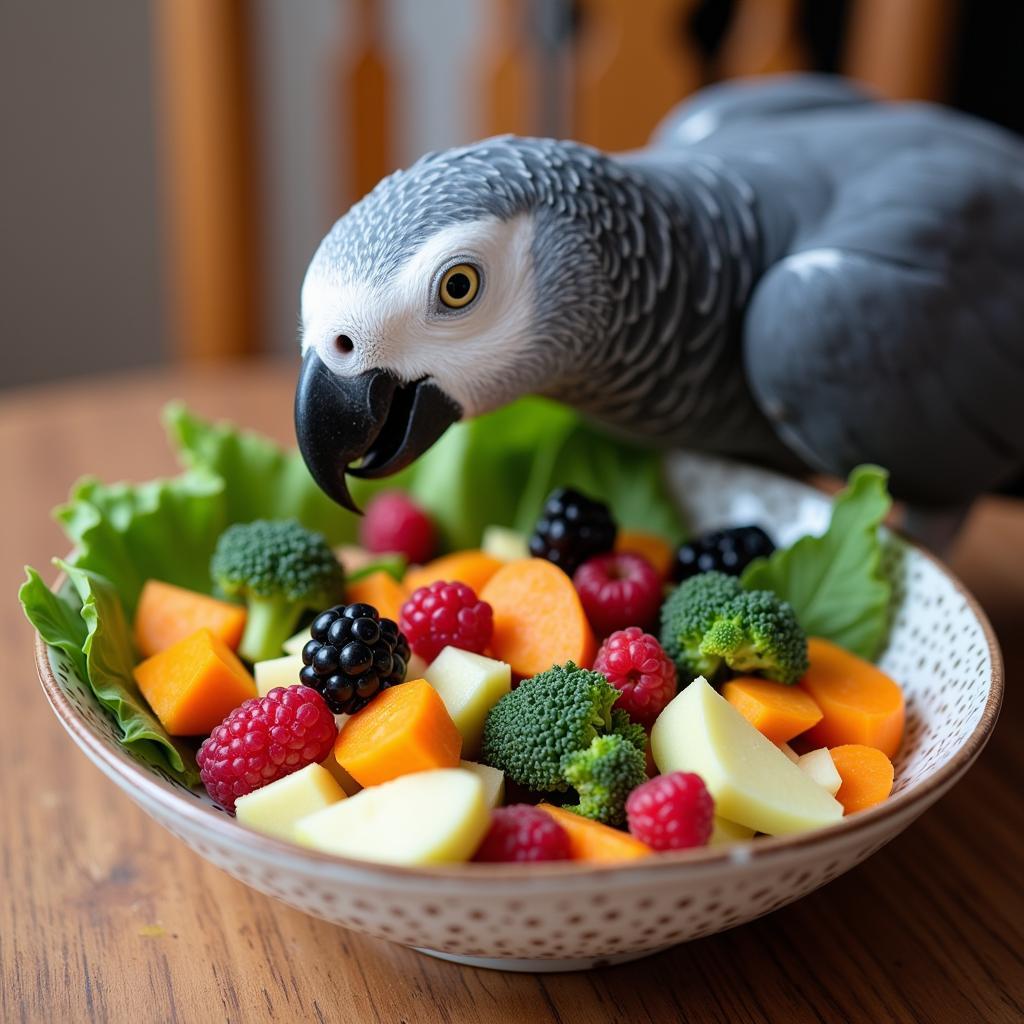The Ultimate Guide to an African Grey Parrot Diet: Keeping Your Feathered Friend Healthy
African Grey Parrots are renowned for their intelligence, charisma, and ability to mimic human speech. However, caring for these amazing creatures goes beyond providing mental stimulation and social interaction. A crucial aspect of their well-being lies in providing a balanced and nutritious African Grey Parrot Diet. This guide delves into the dietary needs of these fascinating birds, ensuring they thrive under your care.
Understanding the Wild African Grey Parrot Diet
In their natural habitat, African grey parrots enjoy a varied diet. African grey parrot diet in the wild consists of:
- Fruits: Figs, berries, and palm fruits form a significant portion of their diet.
- Seeds: They forage for various seeds, providing essential fats and proteins.
- Nuts: African grey parrots are known to crack open nuts for their nutrient-rich kernels.
- Vegetation: Leaves, buds, and flowers offer additional vitamins and minerals.
This diverse diet in the wild ensures they receive a balanced intake of vitamins, minerals, and antioxidants.
Replicating a Balanced African Grey Parrot Diet in Captivity
Replicating this variety in captivity is vital for your parrot’s health. Here’s a breakdown of essential food groups and what they offer:
1. Pelleted Diet (60-70%):
High-quality formulated pellets should form the foundation of an African grey parrot diet. Look for brands specifically designed for African Greys, ensuring they contain a balanced mix of vitamins, minerals, and amino acids.
2. Fruits and Vegetables (20-30%):
Offer a colorful array of fresh produce daily. Safe and nutritious options include:
- Fruits: Apples (remove seeds), bananas, berries, grapes, kiwi, mango, melon, oranges, papaya, peaches, pears
- Vegetables: Broccoli, carrots, celery, green beans, kale, spinach, sweet potato, zucchini
Wash all produce thoroughly and chop into manageable pieces.
 African Grey Parrot Enjoying a Variety of Fruits and Vegetables
African Grey Parrot Enjoying a Variety of Fruits and Vegetables
3. Healthy Fats and Protein (5-10%):
Supplement the diet with small amounts of:
- Nuts: Almonds (unsalted), cashews, hazelnuts, macadamia nuts, walnuts
- Seeds: Chia seeds, flax seeds, pumpkin seeds, sunflower seeds (unsalted)
- Cooked Legumes: Lentils, beans, chickpeas
- Cooked Lean Meat: Chicken, turkey, fish (avoid fatty cuts)
4. Calcium and Mineral Supplements:
Consult your avian veterinarian for appropriate calcium and mineral supplements to prevent deficiencies. Cuttlebone can also provide a source of calcium.
Foods to Avoid:
- Avocado
- Chocolate
- Caffeine
- Alcohol
- Salty or sugary foods
- Processed foods
Creating an African Grey Parrot Diet Chart
Consider creating a weekly or monthly African grey parrot diet chart to ensure variety and track your parrot’s food intake. Rotate the types of fruits, vegetables, and other treats offered to keep your parrot engaged and prevent boredom.
Tips for Feeding Your African Grey Parrot
- Fresh Water Daily: Always provide fresh, clean water in a clean bowl.
- Food Presentation: Use food puzzles or foraging toys to encourage natural foraging behavior.
- Monitor Intake: Pay attention to what your parrot eats and adjust the diet accordingly.
- Consult a Vet: Regular check-ups with an avian veterinarian are essential for monitoring your parrot’s overall health and dietary needs.
African Grey Parrot Diet: FAQs
Here are some frequently asked questions:
1. Can African grey parrots eat peanuts?
While not toxic, peanuts can be prone to fungal contamination and are best avoided.
2. How much should I feed my African grey parrot daily?
The exact amount will vary depending on your parrot’s size, activity level, and metabolism. A general guideline is 1/4 to 1/2 cup of pelleted food and 1/4 cup of fresh fruits and vegetables daily.
3. What are signs of a healthy African grey parrot diet?
A healthy parrot will have bright eyes, clean feathers, good weight, and regular droppings.
4. What are signs of an unhealthy diet in an African Grey Parrot?
Signs of an unhealthy diet can include feather plucking, lethargy, weight loss, and changes in droppings.
5. What is the best way to transition my African Grey Parrot to a new diet?
Gradual introduction is key. Start by mixing small amounts of the new food with the old and slowly increase the ratio over time.
Conclusion
A well-planned African grey parrot diet in captivity is crucial to their physical health, mental well-being, and longevity. By understanding their African grey parrot natural diet and replicating that variety with a balanced approach, you can provide your feathered companion with the best possible care, ensuring they lead a long and vibrant life.
If you require further assistance on caring for your African Grey Parrot, don’t hesitate to reach out. Call us at +255768904061, email us at kaka.mag@gmail.com, or visit our location in Mbarali DC Mawindi, Kangaga, Tanzania. Our dedicated customer care team is available 24/7 to answer your questions and provide guidance.




